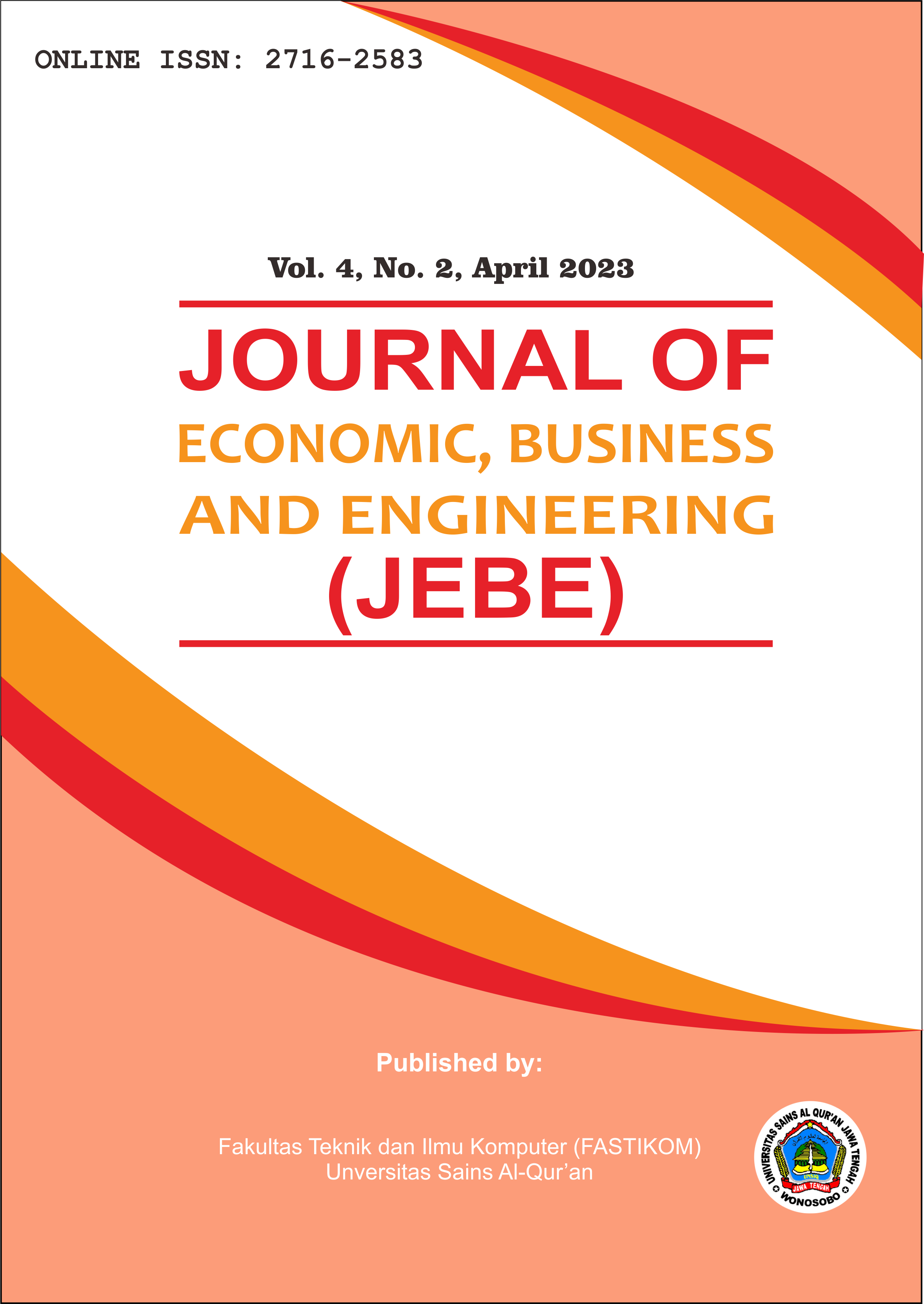KAUSALITAS ANTARA KONSUMSI LISTRIK DAN FAKTOR-FAKTOR YANG MEMPENGARUHINYA: ASEAN-5
DOI:
https://doi.org/10.32500/jebe.v4i2.4468Keywords:
Electricity Consumption, Granger Causality, ECM, ASEAN-5Abstract
Penelitian ini bertujuan untuk menganalisis hubungan kausalitas antara konsumsi listrik dan faktor-faktor yang mempengaruhinya di negara ASEAN-5, yaitu Indonesia, Malaysia, Filipina, Singapura, dan Thailand periode 1971-2014. Variabel penelitian adalah konsumsi listrik, PDB per kapita, urbanisasi, nilai tambah industri, dan inflasi. Data runtut waktu dan panel digunakan untuk model penelitian menggunakan menggunakan metode analisis kausalitas Granger yang dimodifikasi dengan Error Correction Model (ECM). Hasil analisis menggunakan data runtut waktu 5 negara menunjukkan bahwa adanya hubungan kausalitas yang berbeda-beda, baik dalam jangka panjang maupun jangka pendek. Jika data panel yang digunakan, hasil yang diperoleh adalah terdapat hubungan satu arah dari PDB terhadap konsumsi listrik dan dari nilai tambah industri terhadap konsumsi listrik, serta terdapat hubungan kausalitas dua arah antara konsumsi listrik dan urbanisasi serta antara konsumsi listrik dan inflasi. Temuan-temuan dalam penelitian ini menunjukkan bahwa kebijakan, baik di bidang ketenagalistrikan, maupun kebijakan untuk pengembangan daerah dengan faktor-faktor PDB per kapita, industri, inflasi, dan penduduk sangat diperlukan.
References
Alter, N. and Syed, S. H. (2011) ‘An empirical analysis of electricity demand in Pakistan’, International Journal of Energy Economics and Policy, 1(4), pp. 116–139.
Ashraf, Z., Javid, A. Y. and Javid, M. (2013) ‘Electricity consumption and economic growth: evidence from Pakistan’, Economics and Business Letters, 2(1), p. 21. doi: 10.17811/ebl.2.1.2013.21-32.
Bildirici, M. (2013) ‘The Analysis of Relationship between Economic Growth and Electricity Consumption in Africa By ARDL Method’, Energy Economic Letters, 1(1), pp. 1–14.
Chen, S. T., Kuo, H. I. and Chen, C. C. (2007) ‘The relationship between GDP and electricity consumption in 10 Asian countries’, Energy Policy, 35(4), pp. 2611–2621. doi: 10.1016/j.enpol.2006.10.001.
Harsono, T. D. and Kuncoro, M. (2013) ‘Electricity Consumption and Economic Growth : A Causality Evidence from Indonesia, 1984-2010’, International Journal of Business, Economics and Law, 2(April), pp. 8–9.
Hussain Ali Bekhet and NorSalwati bt Othman (2011) ‘Causality analysis among electricity consumption, consumer expenditure, gross domestic product (GDP) and foreign direct investment (FDI): Case study of Malaysia’, Journal of Economics and International Finance, 3(4), pp. 228–235. Available at: http://www.academicjournals.org/JEIF.
International Energy Agency (IEA) (2015) ‘Southeast Asia Energy Outlook’, World Energy Outlook Special Report, p. 131.
International Energy Agency (IEA) (2016) Reducing Emissions from Fossil-Fired Generation Indonesia, Malaysia, And Vietnam.
International Energy Agency (IEA) (2017) Energy Access Outlook 2017 from Poverty to Prosperity.
Iyke, B. N. (2014) Electricity Consumption, Inflation, and Economic Growth in Nigeria: A Dynamic Causality Test.
Kraft, J., dan A. K. (1978) ‘On The Relationship between Energy and GNP.” Journal of Energy and Development’, On The Relationship between Energy and GNP, 3, pp. 401–403.
Krugman, P. (1991) Geography and Trade. Cambridge MA: MIT Press.
Lean, H. H. and Smyth, R. (2010) ‘CO2 emissions, electricity consumption and output in ASEAN’, Applied Energy, 87(6), pp. 1858–1864. doi: 10.1016/j.apenergy.2010.02.003.
Lee, C. C. (2005) ‘Energy consumption and GDP in developing countries: A cointegrated panel analysis’, Energy Economics, 27(3), pp. 415–427. doi: 10.1016/j.eneco.2005.03.003.
Liddle, B. and Lung, S. (2014) ‘Might electricity consumption cause urbanization instead? Evidence from heterogeneous panel long-run causality tests’, Global Environmental Change, 24(1), pp. 42–51. doi: 10.1016/j.gloenvcha.2013.11.013.
Lin, B. Q. (2003) ‘Electricity demand in the People’s Republic of China: Investment requirement and environmental impact’, ERD Working Paper Series, (37), pp. 1–25.
Mozumder, P. and Marathe, A. (2007) ‘Causality relationship between electricity consumption and GDP in Bangladesh’, Energy Policy, 35(1), pp. 395–402. doi: 10.1016/j.enpol.2005.11.033.
Phoumin, H. and Kimura, S. (2014) ‘Analysis on price elasticity of energy demand in East Asia: empirical evidence and policy implications for ASEAN and East Asia’, ERIA Discusssion Paper Series, 05, pp. 1–26. Available at: http://www.eria.org/ERIA-DP-2014-05.pdf.
Shahbaz, M. and Lean, H. H. (2012) ‘Does financial development increase energy consumption? The role of industrialization and urbanization in Tunisia’, Energy Policy. Elsevier, 40(1), pp. 473–479. doi: 10.1016/j.enpol.2011.10.050.
Solarin, S. A. and Shahbaz, M. (2013) Trivariate causality between economic growth, urbanisation and electricity consumption in Angola: Cointegration and causality analysis, Energy Policy. doi: 10.1016/j.enpol.2013.05.058.
The ASEAN Secretariat (2015) A Blueprint for Growth ASEAN Economic Community 2015: Progress and Key Achievement. Jakarta, Indonesia.
United Nations (1998) World Urbanization Prospects The 1996 Revision: Estimates and Projections of Urban and Rural Populations and of Urban Agglomeration.
World Bank (2023) World Development Indicators. Available at: http://data.worldbank.org.
World Development Indicators 2016 (2016) World Development Indicators 2016. doi: 10.1596/978-1-4648-0683-4.
Yoo, S. H. (2005) ‘Electricity consumption and economic growth: Evidence from Korea’, Energy Policy, 33(12), pp. 1627–1632. doi: 10.1016/j.enpol.2004.02.002.
Yoo, S. H. (2006) ‘The causal relationship between electricity consumption and economic growth in the ASEAN countries’, Energy Policy, 34(18), pp. 3573–3582. doi: 10.1016/j.enpol.2005.07.011.







